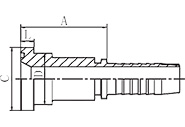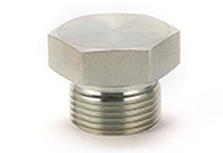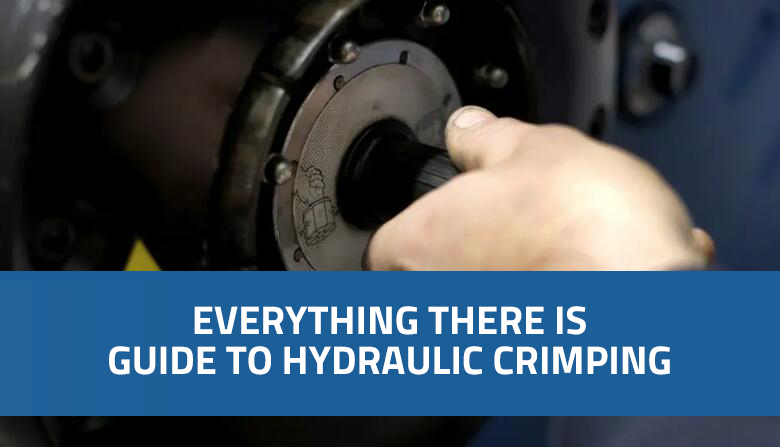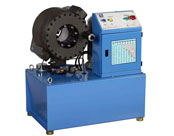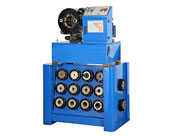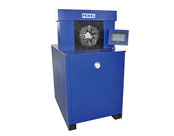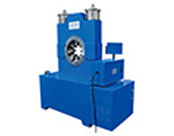Everything There Is Guide To Hydraulic Crimping
Hydraulic crimping is well-known among professionals in the power or electrical industries; crimping is used for a wide range of applications.
Crimping is the process of creating an electrical crimp — a type of solderless electrical connection — in the context of electrical work. The same principle holds true when crimping wires, cables, and hoses, such as hydraulic hose crimping machine. A crimping machine compresses metal around a coupling by squeezing and deforming the material between the two pieces of metal, resulting in an airtight and permanent seal.
We've compiled a list of frequently asked questions about hydraulic crimping that you might find useful. Continue reading to learn everything there is to know about crimping.
Guide to Hydraulic Crimping
Table of Contents
- 1.What Is A Hydraulic Crimper?
- 2.How Does A Hydraulic Crimper Work?
- 3.What Is The Advantage Of Crimping?
- 4.Hydraulic Crimping vs Machine Crimping
- Pros and Cons of Hydraulic Crimping
- Pros and Cons of Machine Crimping
- 5.What Is A Hydraulic Crimper Used For?
- 6.Types of Hydraulic Crimper
- 7.Related Questions
- What Is The Difference Between Crimping And Swaging?
- Can You Crimp Without A Crimping Machine?
1.What Is A Hydraulic Crimper?
A hydraulic crimper is a tool that is used to join the ends of two cables, wires, or other similarly flexible materials, such as hydraulic hoses, to a matching hose end. This tool enables the user to make crimped connections by transferring force from the user to the tool via a hydraulic crimper machine.
Swavers, swaging presses, and hydraulic crimping machines are all names for these machines. The crimp head is the key component in the system that produces the crimping. The majority of crimp heads on the market are single-acting hydraulic cylinders that open and close mechanical dies via various sliding faces.
2.How Does A Hydraulic Crimper Work?
A hydraulic crimper works by forcing a piston down into a cylinder, where it compresses a die against the cable, wire, or hose being worked on. As a result, the die develops a permanent bend at the point of contact. When the pressure is released, the die springs back up, leaving a permanently bent section of wire, hose end coupling, or cable crimp behind.
The hydraulically operated die opens and closes by pushing against a stationary face on one side of the cylinder. The hydraulic pressure forces the die into contact with another surface as it pushes down. When the desired amount of compression or size has been achieved,The hydraulic system's pressure is released, forcing the die back out. In this manner, the die can be opened and closed repeatedly until enough material is compressed to form a permanent seal between the surfaces. It is only recommended to crimp hydraulic hoses once and to a set size determined by the manufacture of the hose and hose end. Leading hose and fitting manufacturers also strongly advise against mixing and matching different brands of hydraulic hose and couplings because hose manufacturing dimensions and fitting tolerances vary between manufacturers . Ignoring this could result in the hose failing under pressure (hydraulic hose failure), causing significant equipment damage, personal injury, or death.
After that, the hydraulic crimping head can be retracted, allowing you to remove the crimped hose without fear of damaging the newly formed connection.
3.What Is The Advantage Of Crimping?
Crimping has a number of advantages. The primary advantage of crimped connections is that they form an airtight seal between the connector and the cable, wire, or hose, resulting in a long-lasting and reliable connection that is protected from environmental conditions such as moisture, sand, dust, and dirt.
When used to crimp hydraulic hose ends, crimpers save labor time and strain over alternative joining methods such as field attachable connectors.
4.Hydraulic Crimping vs Machine Crimping
The decision between a hydraulic and a mechanical crimping tool will be influenced by factors such as preference, budget, and application. Hydraulic crimping tools are either handheld or remote compression tools that use hydraulic fluid's power. Machine crimping tools, on the other hand, must be operated with brute force. Most modern hydraulic hose crimpers are hydraulically powered, with an electric motor driving the hydraulic pump and solenoid control valves controlling the crimping head movement.
Pros and Cons of Hydraulic Crimping
Hydraulic crimpers have numerous advantages. They have much greater force than mechanical crimpers and advanced digital interfaces to increase productivity. Because these machines are hydraulically powered, they require little to no human input, eliminating human error and drastically reducing human labor. There are numerous models suitable for any size workshop.
When compared to mechanical crimps, hydraulic hose crimpers are superior because they save time and effort. Because there is less strain involved, they work faster than human hands. Furthermore, unlike mechanical crimps, these machines enable you to crimp larger diameter hoses without fear of breaking them.
Unlike mechanical crimpers, which require manual force, all you have to do when the crimper comes into contact with the end of the hose is press a button. There will be no more bending down and stretching to reach difficult-to-reach areas.
The main disadvantage of hydraulic crimpers is the higher initial investment. Although they save money in the long run, they are more expensive to purchase than a mechanical crimper.
Pros and Cons of Machine Crimping
Since the introduction of hydraulic crimping machines, mechanical crimping machines have fallen out of favor. They do, however, retain some advantages.
Crimping machines are significantly less expensive, making them more cost-effective for a company to purchase in bulk for employee use. Furthermore, they may be easier to repair if a part needs to be replaced or repaired.
Crimping machines are not inherently bad, but their performance is inferior to hydraulic machines. Manual versions are slower, less versatile, and necessitate more physical labor than hydraulic versions.
5.what-is-a-hydraulic-crimper-used-for?
Hydraulic crimpers are mostly used in industrial settings such as plumbing, electrical wiring, and automotive assembly. Crimpers can also be used to create a permanent coupling between a hydraulic hose and a hose fitting. These crimpers are ideal for large-scale production lines with high manual labor costs.
Businesses have been able to reduce their reliance on manpower and the amount of downtime caused by employee errors by automating this process. This enables businesses to keep up with rising demand while remaining competitive.
This method of joining is quick to execute, can be performed outside of the workshop, and extends the lifespan of repairs when hydraulic crimpers are used for repair work.
6. Types of Hydraulic Crimper
Depending on your requirements, hydraulic crimpers come in a variety of styles. Because each crimping tool has a different capacity, it's critical to know what force and size you'll be working with before purchasing a machine.
Electric Hydraulic Pipe Hose Crimping Machine
Hose crimping machine (PH-TCR-B32 ) is normally used in crimping hose fitting assembly or repair service, it can crimp from 1/4” to 1-1/4” (1-4SP hydraulic hose). There are 13 sets of standard dies, so different sizes of dies makes the hose crimper more easier and multi-role.Electrical Hydraulic Pipe Hose Crimping Machine
Hose crimping machine (PH-TCR-B51) is normally used in crimping hose fitting assembly or repair service, Our Crimping machines can crimp from 1/4” to 2” (1-4SP hydraulic hose). There are 13 sets of standard dies, so different sizes of dies makes the hose crimper more easier and multi-role. Also, PH-TCR-B51 is equipped with a die table and quick change tool, they can offer lots of convenience to the operators.Hydraulic Hose Crimping Machine, Plumbing Crimping Tool
Electric hydraulic pipe hose crimping machine (PH-LCR-B140 ) plumbing crimping tool hydraulic hose max 1 1/4''. big size crimping machine, plumbing crimping tool. Good quality high pressure automatic wire stripping and terminal up to 6" hose crimping machine
If you are not sure which type of hydraulic crimper is best for your needs, PEHEL hydraulic reputable hydraulic crimper suppliers can help you determine which is right for your requirements.
7.Related Questions
What is the difference between crimping and swaging?
Crimping and swaging are both methods for forming water and airtight seals around components such as hydraulic hoses. The end result is very similar, but the path they took to get there differs.
Crimping is the process of applying pressure in all directions to a hose coupling to create a tight seal. The pressure is applied evenly via a die that closes slowly and only once.
Swaging is the process of shaping an angular coupling down to a smaller, sealed circular shape using quick continuous closures. The constant, high-pressure closing shapes the coupling around the hydraulic hose and welcomes the circular shape.
Can you crimp without a crimping machine?
Without a crimper or crimping tool, there is no proper way to crimp connections. While manually compressing metal connections with pliers or other tools is possible, the results are not reliable or secure.
If using a crimping tool isn't an option, it's better to use a different joining method than to perform a poor quality crimp. If you frequently crimp connections, it may be worthwhile to invest in a hydraulic crimping tool.
Conclusion
Is it possible to crimp without a crimping machine?
Without a crimper or crimping tool, there is no proper way to crimp connections. While manually compressing metal connections with pliers or other tools is possible, the results are not reliable or secure.
If you need to crimp connections frequently, it may be worthwhile to invest in a hydraulic crimping machine.
PEHEL's hydraulic hose crimping machines and tool systems aid in the production of hydraulic hose assemblies in a timely and efficient manner. The hydraulic hose crimper machine allows any user to produce hydraulic hose assemblies in-house. A crimper can help you save time and money.
If you don't want to invest in a larger, industrial crimper, a diverse range of crimping tools are available at a variety of price points. To crimp hydraulic hoses, a variety of smaller, hand-pump crimpers are available, which require a lower initial investment than workshop or production crimpers.
Whether you're a mechanic, engineer, or just someone who loves learning about technical things, We are Hydraulic Hose Fittings Suppliers . Please feel free to contact us if you are interested in our products. Visit PEHEL hydraulic to know more about Ferrule fittings and Contact PEHEL hydraulic .





